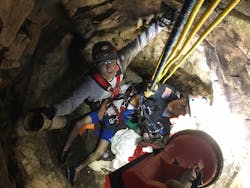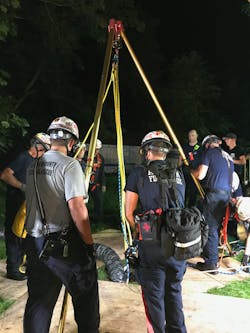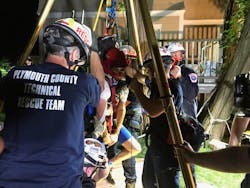Confined-space incidents for any fire department can be difficult to mitigate because of unknown circumstances. A fire hazard? A mechanical hazard? An atmospheric hazard? In other types of technical rescue incidents that a fire department might encounter, the hazards usually are obvious.
If it’s a water rescue, the potential hazard is drowning; if it’s a cliff rescue, the hazard is the potential of falling; if it’s a collapsed building, the hazard is the potential of being crushed by shifting or falling debris.
In confined-space incidents, the unknown and unseen hazards usually pose the greatest risk for victims and rescuers alike. Most commonly, the unseen hazard is atmospheric.
An 18-inch opening
Just after midnight on July 19, 2017, a 37-year-old man went into the backyard of his apartment building to look for his dog. When that individual didn’t return, a family member became concerned and went to look for the individual in the backyard.
The 37-year-old man fell approximately 15 feet through a small opening in tall grass into a cesspool or septic tank that was taken out of service several years prior. The family member called the fire department and stated that her dad was walking outside and he fell in a hole. First responders were dispatched, and, upon arrival, the Cohasset, MA, Fire Department started sizing up the scene. Upon investigation, they found that the man fell straight through an opening that was 18–20 inches wide. The man complained of head and leg injuries, and he persistently asked the rescuers to get him out.
The fire department recognized the need for specially trained personnel who had specialized equipment. The department notified the Plymouth County Technical Rescue Team (PCTRT) to respond. (The PCTRT is one of the five county teams that make up the Southeastern Massachusetts Technical Rescue Team region. This region covers thousands of square miles, from just south of Boston to the islands off of Cape Cod.)
The department set up a perimeter and established an incident command post. It was able to get a pencil ladder into the hole to permit a rescuer to establish patient contact. The department member had a four-gas meter with him and started patient care.
The first member of the PCTRT to arrive was the team director. As per protocol, the team leader interfaced with the incident commander (IC) to get an update on the situation and to find out what the IC needed from the technical rescue team.
As more PCTRT members arrived, including with trailers, the accountability board was set up, and equipment was staged, ready to be put into place.
Two PCTRT members conducted a recon of the area where the individual fell into the confined space and where the fire department was in contact with the victim. A rescue leader was placed in charge of the rescue by the team director. The rescue leader’s plan called for setting up a tripod system with a rope-retrieval system and a belay system for the protection of rescuers and the victim. Nearby railroad tracks, which handle commuter and commercial traffic, were shut down to reduce vibration.Rescuer with low O₂
While equipment was brought in and set up in the Hot Zone, ground pads were placed around the hole to displace the weight of the attendants and rescuers who were near the opening of the confined space. (The two outside attendants, who constantly monitored the confined space, were a member of the fire department and a member of the PCTRT.)
Per standard protocol, another four-gas meter was called for, to verify safe atmospheric conditions for the rescuer and the victim. PCTRT discovered that its battery-operated four-gas meters were dead. (The batteries weren’t on a constant charge while in storage.) It would take too much time to put the four-gas meters onto a charge via a generator.
Eventually, the technical rescue liaison chief, who was working with the fire department’s chief, offered up the charged four-gas meter that was in his vehicle.
That four-gas meter was brought to the confined space with a small piece of webbing for atmospheric monitoring at all levels. The meter was placed into the hole via the outside attendant from the PCTRT, and shortly thereafter the meter went into alarm: The oxygen level in the confined space was low.
The rescue leader ordered the rescuer from the fire department out of the confined space and requested that a RAMFAN ventilation fan that was being set up be placed in the opening of the confined space.
After the ventilation fan was set up, atmospheric monitoring continued, and rather quickly thereafter the oxygen level returned to normal (20.9 percent). (When the fire department tested the atmosphere before entering the confined space, the atmosphere was adequate for entry. It was inferred that the rescuer and victim breathing in the confined space lowered the atmosphere below the Occupational Safety and Health Administration’s 20.9 percent threshold.) Simultaneously, portable lighting was set up around the Hot Zone in the way of battery-operated box lights. Those were discovered to have dead batteries, too. Alternate lighting was put in place quickly.
While this happened, the tripod and rescuers were set up in preparation to go into the hole. Safety checks of each of the two rescuers, the equipment and the entire scene were conducted.
While rescuers were lowered into the hole, there was discussion as to the type of packaging device to use to get the victim out. He continued to complain of great leg pain and possible head injuries. Because of the small opening to the space, a Yates Spec Pak patient packaging and extrication system was used.
The victim’s injuries were treated in the confined space as best as possible, and then he was placed in the patient packaging and extrication system. The team started to hoist the victim through the narrow opening but found it difficult to get the victim’s shoulders through the top of the confined space. Even with the packaging and extrication system, the rescuers found that they had to get one of the victim’s shoulders through initially and then manipulate the second shoulder to hoist the victim high enough to be transferred to a stretcher.
Care for the victim was transferred to the fire department paramedics. While they transported the patient to a waiting medical helicopter, they treated him continuously. The helicopter took the victim to a Boston hospital based on the mechanism of injuries and his time in the confined space. The fire department did a great job of identifying the confined space and calling the team in early. They also did a remarkable job of medically treating the patient while waiting for the team. Once a technical rescue team was on scene, it took approximately 40 minutes to get the patient out of the confined space to a waiting ambulance.Problems and successes
The major problem of this rescue was the lack of properly charged battery-operated equipment. Having batteries constantly on charge even when in the trailer in their storage area is key.
Another delay that was incurred arose when the fire department didn’t know the nomenclature or the equipment that the technical rescue team utilized. According to the rescue leader, Alex Merry, it would be beneficial to “possibly cross-train with the local fire departments, so they will understand what the equipment is and how it is used at a rescue scene.”
Once the technical rescue team was on scene, the patient packaging and extrication happened relatively quickly. Getting that specialized team of personnel, equipment and training was key to the rescue. According to Cohasset Fire Department Assistant Chief John Dockray, “Having a member of the fire department on the [PCTRT] made [the department] aware that the team was available for this type of rescue and regularly trains for these types of incidents.”
Control the knowns
In confined spaces, the leading cause of accidents and deaths arises from atmospheric hazards. Unfortunately, there are no obvious signs to cue the rescuer to mitigate the hazard. The one tool that most fire departments possess to mitigate the hazard of a confined space is a multi-gas meter.
Fire departments must prepare for the low-frequency, high-risk events that are technical rescues. Technical rescue teams must train on the target hazards regularly and ensure that equipment is ready to go at a moment’s notice.
About the Author
Mark McCabe
Mark McCabe is a 30-year member of the fire service with experience in fire suppression, hazardous materials, fire prevention and fire instruction. Since 1993, he has been a fire instructor who teaches in all fire service subjects. McCabe specializes in the instruction of technical rescue and currently is the coordinator of Technical Rescue for the Massachusetts Firefighting Academy (MFA). As a current team leader of the Southeastern Massachusetts Technical Rescue Team, he responds to technical rescue incidents within the commonwealth of Massachusetts. For 24 years, McCabe was a rescue specialist and squad officer with FEMA’s Massachusetts Urban Search and Rescue team, having been deployed for incidents from natural disasters to the World Trade Center on 9/11. He is a certified Rescue Technician, Hazardous Materials Technician and EMT, and he holds numerous professional career certifications. McCabe earned his bachelor’s degree in fire science in 2017 and his master’s degree in public administration in 2018, both from Anna Maria College, and completed the Chief Fire Officer Training Program at the University of Massachusetts Edward J. Collins Jr. Center for Public Management in 2019 at the MFA.


